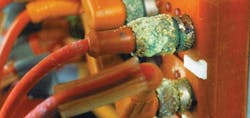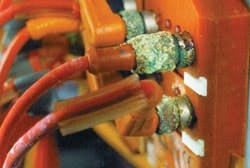We regularly describe sophisticated networking systems, complex control algorithms and elegantly structured hierarchical computer systems. But, like an inexplicably non-functioning home appliance, they won't work if they're not plugged in.
Loose connections, sometimes caused by the very machinery to which they're attached, are among a host of wiring and connection problems that can bring to a halt the most carefully developed and hardworking networks.
We surveyed end users, machine builders and OEMs for a list of the most common wiring and connection problems. Here are some, along with their solutions. Each of these problems has numerous variations, as well as solutions, many of them vendor-specific.
(1) Vibration/Loose Wiring
Problem: Vibration in industrial applications can cause terminated wires to loosen, resulting in broken or intermittent connections.
Solution: Screw-down and gas-tight connections, such as those seen in spring-clamp and IDC-type terminal blocks, can prevent loosening of wires. Spring-clamp terminal blocks are especially good for stranded-wire applications because the conductor is completely captive within the spring clamp.
"We used to manufacture our own boards for emergency power-off boxes, and we used a type of connector that was always working itself loose," recalls Darren Willey, chemical systems supervisor in the Boise, Idaho, plant of semiconductor manufacturer Micron Technology. "There was no solid latching of the connector; it just slid on to individual termination points. Plus it was very labor-intensive for us to make all these connections."
Willey said Micron turned to a prefabricated board-level component "with all the connections on the board. Plus the whole component is DIN-rail-mounted — it just snaps in." The spring-loaded insertion keeps constant pressure on the component, ensuring a good connection.
Similar problems were faced by Se-Mar Electric, a West Seneca, N.Y., manufacturer of electrical control panels. "One plant we installed a system in had large, reciprocating equipment, which was always working the connections loose," says Rich DiChristina, quality control supervisor. "We simply used large cage clamps with spring clips. They provide constant positive pressure, and loosening connections were no longer a problem."
(2) Electrical Interface
Problem: Industrial equipment can generate strong electromagnetic fields that degrade analog and even digital signal integrity.
Solution: Route cables in shielded, grounded conduit as far from electromagnetic interference sources as possible.
With lots of robots, welding stations and similar pieces of high-power electrical equipment, "electromagnetic interference (EMI) has been one of our biggest problems," says Terry Shell, network specialist at Toyota Motor Manufacturing North America's Georgetown, Kentucky, assembly plant. "Signals get distorted. There are lots of collisions on the network. With most of the machinery having Ethernet connections, it's difficult to route wiring without getting EMI."
Toyota instituted a two-pronged defense: route the cables as far away from sources of EMI as possible and run the cables in conduit. "But make sure the conduit itself is grounded properly," Shell adds. "That made a world of difference."
Shielded cables and grounded conduit alone were not enough. "We also install all our networked cable and conduit 25 ft off the floor and run the connections up to that height," Shell continues. "Putting the cables overhead seemed to be the only way to avoid EMI; plus, it keeps the cables off the floor and away from other problems."
You would think ac power lines and a DCS signal would have different enough frequencies that one wouldn't affect the other. That wasn't the case at Eastman Chemical's Longview, Texas, plant. "We had a data highway for the DCS running in conduit next to a cable tray with a 60 Hz ac power supply, and we were getting intermittent interference," says Ray Vincent, principal electrical engineer. "The DCS workstations would go blank. It turned out there was a variable-speed drive on that ac line that was the cause of the problem."
The solution was to put the power line, especially the leads to the variable-speed drive, in conduit also. Generally speaking, "don't put a variable-speed drive anywhere near fieldbus," Vincent warns.
(3) Corrosion, Moisture
Problem: Airborne chemicals, cleaning applications or salt spray can result in corrosion of metal contact parts in terminal blocks. Consequently, this can affect the integrity of the connection.
Solution: Corrosion can be battled by purchasing a fully enclosed block to protect metal parts. Choosing contact material made of zinc-plated steel will also reduce the chance for corrosion. If metal is exposed, engineers should choose a block with fully extruded metal with no seams. Seams foster corrosion.
"We had a water treatment plant that was experiencing intermittent problems with an I/O cabinet and chassis of computer input/output cards. It was five stories underground. As soon as I got there, I could smell the chlorine in the air," recalls Se-Mar Electric's DiChristina. "When I opened the cabinet, everything copper in it was green. The cabinet was vented, allowing in lots of chlorine gas."
DiChristina says there are two obvious solutions: Take the control panel out of that environment, or seal it and purge it so the chlorine cannot get in. In this case, removing the panel to an air conditioned control room was easier. "Once everything was cleaned up and the damaged parts replaced, the intermittent problems went away."
Moisture might be an occasional and unexpected problem in some industries, but it's a fact of life in the food industry, where sanitizing washdowns are required at least daily. That kind of environment is tough on electronics.
"When you wash a 35° meat plant with 200° water, you create a lot of condensation," says Jeff Morgan, sales manager for Hermitage Automation, a Richmond, Virginia, automation and controls integrator. That moisture consistently was destroying photoelectric sensors. "Even with the sensors mounted upright, moisture was weeping upward into them. For a while there, we sold them a lot of replacement sensors and wiring."
A more detailed study of the problem led Hermitage to try a quick-disconnect sensor with a molded-case cable. Fully gasketed, it gave the application the required IP67 enclosure rating. Even under the damp conditions of that meat packing plant, it protected the sensor.
(4) Labeling and Identification
Problem: Inconsistent labeling practices can obscure needed information and/or complicate diagnosis and troubleshooting.
Solution: Label terminal blocks above the termination point, and label wires based on destination. Try new software solutions for keeping complex wiring jobs straight.
"Different people use different wire orientations. Even with set practices, technicians in a hurry may take shortcuts to get a system back up and running," says Lee Marks, senior electrical engineer in the processing facility of Barrick Goldstrike Mines, Elko, Nevada. "You start troubleshooting a problem and you might find a problem wire, but you have no idea where it goes. That can waste a lot of time. Downtime can cost us $50,000–$60,000 an hour, so we can't waste time figuring out where some old wires are going.
"The solution was to standardize on marking all our wiring by destination, no matter where in the plant the wire is found. It's not so important where the wire's at or where it's coming from, but where it's going. It takes discipline to get people to adhere to this practice even when they're in a hurry, but it will save us time the next time we deal with that wire or cable."
Ever need more than one wiring schematic for a large machine? Maybe even several versions of diagrams for a single section?
"Our automated pellet-testing machine starts with a three-phase 80 V input, then drops to 24 V for the main PLC, 15 V for some current sensors, and 12 V for a specialty motor," says Joe Messenger, electrical integrator in the Oconto, Wisconsin, plant of Vishay Cera-Mite, a manufacturer of ceramic capacitors. "All in all, it has voltages from 0 to 480 V, some ac and some dc, 448 I/O points, and 118 air and vacuum valves. The only way to keep track of that many wiring items is with software."
Messenger says it would be impossible with manual methods to coordinate not just wire placement but where to pick up a certain voltage from a previous section. Then, coordinating the fractional schematics together into the overall picture would be complex.
"Managing all this in a schematic is an immense job," he says. "But the software program we use allows me to segment the machine into several drawings and lay out my I/O one section at a time. I can edit and change drawings or create several variations of the same segment. It keeps wire numbering consecutive. You can even build devices with it. You've got to get software."
(5) Flexibility/Stress
Problem: Repetitive movements can lead to wire fatigue and breakage.
Solution: Use highly stranded wires and avoid movement when possible.
If human joints and nerves can suffer from repetitive motions, imagine what thousands or even millions of cycles can do to cable.
"The packaging machines we install may make a motion once a minute or once a second. Either way, that's a lot of movement for wires," Hermitage Automation's Morgan says. "If you've got high speeds of a pick-and-place motion and you throw in a little torsion, you've got the perfect recipe for stressed wiring."
Fortunately, there are myriad wiring solutions out there for this common problem. "Most of the time, you're going to want highly stranded wires. A single, 16-gauge wire is not going to stand up very long, but several hundred strands, which together carry what a 16 gauge can, will take that kind of repetition for an awfully long time," Morgan says.
ALSO READ: Don't let poor wire and cable decisions slow down your next project
About the Author
Dave Fusaro
Dave Fusaro

Leaders relevant to this article:

